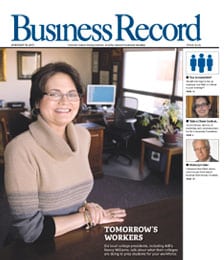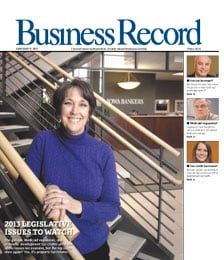Horsing around

Deb Pulver was one of the lucky kids who, when they asked for a pony at five years old, actually got one.
Now her love of horses has become more than just a hobby. Six days a week, Pulver is in Cumming, training with her two horses for competitive shows in Arizona and California.
“It is a passion of mine,” she said. “I’m very attached to my horses. I do spend at least two hours a day with each one in training. So I do care about them.”
Pulver competes in dressage, which is one of the many disciplines one must choose from to show a horse competitively. Dressage, from the French word for “training,” is often described as the art of dancing on horseback. Dressage tests are designed to improve a horse’s balance and flexibility, as well as improving communication between horse and rider. At the lowest levels, dressage tests are very simple, with the emphasis on basic training. In the training level tests, the judge is looking for the horse to be moving forward freely and in good rhythm. Those tests are straightforward, with simple transitions, circles and diagonals used to demonstrate the horse’s progress in its training.
The dressage tests get progressively more difficult as the rider goes through five different levels, then the Prix St Georges test and two intermediate tests before reaching the Grand Prix level.
“You’re training a horse to do what you want it to do,” she said. “It is still amazing to me that a horse that weighs 1,200 pounds is submissive enough to take directions.”
Pulver trains all summer, then in the winter travels with her two horses, Keoliet and Piloot, to Arizona for several months. She loads up the horses and equipment and heads off to the shows, living out of her trailer all through the winter in order to stay close to the horses. She then returns in the summer to start training for the next level.
“I think it is important to point out that to do this, you must have a very supportive spouse,” she said. “Mine is very supportive. He has no interest at all in riding, but he comes out to the competitions and cheers me on.”
Pulver recently trained with the Canadian champion in dressage in hopes that one day she can achieve the Grand Prix level. She said if she’s lucky, she will reach that goal in five years.
“These horses are athletes, so you have to worry about injury just like any other athlete,” she said. “But if we keep working, it’s possible that one day we could make it.”
Also just like any other athletes, they must get top-notch care. Pulver has hired a nutritionist, a veterinarian, a masseuse and an acupuncturist to ensure the horses are well taken care of.
“They live a pretty good life,” she said.
Susan Knapp is another local woman who has started showing horses competitively. She said she got into the sport recently as something she could do with her kids.
“We would do local shows on the weekend just for fun,” she said. “I did my first real competition in Lincoln, Neb., in October. I was happy just to be there. My daughter shows with me, so it’s something we can do together.”
Knapp said horses are very therapeutic for her, and when she rides them, she feels complete. She currently owns 11 horses, and it takes a lot of work to train and care for that many animals.
“I’m fortunate; I have a stable manager,” she said. “She is absolutely wonderful. There is no way I could do it all myself.”
Both women have been successful thus far in their competitions. Knapp said she and her horse are leading Iowa in her discipline, which is hunter seat. Pulver’s two horses are both climbing toward her goal. Keo, the 14-year-old, is level five, and Piloot, the nine-year-old, is between levels three and four. Both are Dutch warmbloods.
“The higher level you are, the more athletic you have to be,” Pulver said. “It’s physically exhausting. Routines at lower levels are seven minutes. Once you get to the upper levels, it lasts for 12 minutes. It’s challenging mentally and physically for the rider.”
For their freestyles, riders and horses perform specially choreographed patterns to music. This winter, Pulver will be performing with her horses to the theme from Ghostbusters, a song she didn’t necessarily want to use, but she said it just seemed to work.
“Wasn’t my first choice, but (the horse) really responded to it,” she said.
As hobbies go, this one is a bit expensive, Pulver said, but it is also very rewarding.
“The purchase of a horse is expensive, but that is a one-time expense,” she said. “Then you have to pay for food, shoes, equipment and all the everyday care. It isn’t cheap. But we love it.”
And luckily, Pulver jokingly said, there isn’t any money in it.
“I do it just for fun,” she said.
Knapp said she, too, isn’t doing this for fame or fortune. It is a labor of love, and the thrill of the competition is worth the work she puts in.
“I had a lot to learn when I started doing this,” she said. “But it is worth it. I enjoy it too much to give it up.”
Pulver said she is going to continue to work with her horses and compete until she is no longer physically able to do it.
“The older you get, the harder it becomes,” she said. “But I have no intention of stopping anytime soon. I just love it too much.”







